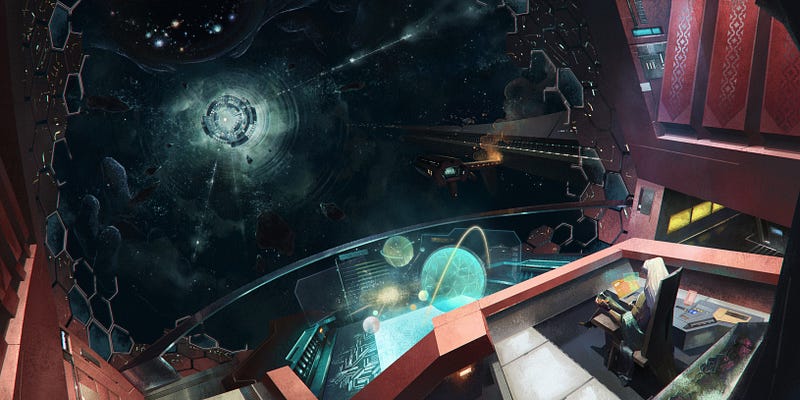
Ambrosia Sky is a first-person immersive sim where the only thing standing between you and the answers you seek are treacherous zero-G anomalies, deadly alien fungus with their own unique abilities, and the creeping guilt that maybe if you hadn’t abandoned this place all those years ago, everyone you used to know might still be alive.

Ambrosia Sky: Act One will be your sombre homecoming to a colony that is overrun with a vibrant, alien ecosystem. Adapt and survive encounters with various forms of hostile fungi that will burn, electrocute, and overwhelm you. Harvest their fruit to craft powerful new chemical agents to fight back or open new avenues of exploration. And pick through the desiccated remains of a once populous colony as you journey into strange depths to unravel the dark mystery that left its inhabitants dead, missing, or maybe even complicit.
Ambrosia Sky’s unique gameplay blends rewarding exploration with meditative cleaning. Use your chemical sprayer to cleanse unique strains of deadly fungi, each one trying to burn, electrocute, or trap you. Study their behaviours and harvest their fruiting bodies to craft powerful upgrades, like electrical foam you can use to reroute power to power doors or consoles.
The stylized world of Ambrosia Sky is a living ecosystem with both the hostile fungus and the remnants of those who once lived there. Explore a series of environments across a range of mission types, using your tether to traverse unstable gravity fields or reach hidden passages to uncover the mystery of the Cluster.
Your mission isn’t purely personal. As part of an enigmatic order of scientists in pursuit of human immortality, you are also tasked with finding victims of the contamination whose DNA can be studied. Find these chosen deceased, perform a sacred ritual to further your research and understand the disaster through the lives of the people destroyed by it.
ABOUT THE DEVELOPMENT TEAM
Soft Rains is a Toronto, Canada-based game studio focused on delivering world-class development experience in our work, from world-building and memorable storytelling to immersive gameplay and art.

In this weeks devlog, we speak to Greg Harrison and Michelle Hwu, the composer and audio director for Ambrosia Sky, respectively. They share insights into using sound & music as worldbuilding, discuss the instruments and methods used in composing tracks for the game, and reveal the first full track for the game (demo players will recognize it!): Geralds Last Rites .

Can you describe how you approached the music for the Clusters different generations?
Michelle: When I first learned where and when our game takes place, I got really curious about how music and art might have been created and preserved in our futuristic, sci-fi world. Kait outlined the three generations of humans that lived on the Cluster, which helped shape my understanding of how music might have evolved over roughly 200 years. People leaving Earth for Saturn would have brought only specific items and materials, which would impact what could be preserved over time. I wanted my early exploration of the music lore to serve as a foundation for our games soundtrack.
From there, I came up with some loose guidelines for each generation and how that would influence the games sound. For example, I imagined that when people first arrived on the Cluster, wood was scarce, large instruments were hard to come by, and they had to make do with whatever they could find, such as metal scraps from ships, mycelium, and beast bones. That got me thinking about how we could incorporate a sense of primitive technology and accessible instruments into the games music, using items like bones, jaw harps, ocarinas, and conches. I was introduced to Grejs music, which felt like a perfect match for our worldhes well-known for blending organic and electronic sounds in a really compelling way, and I knew he would be able to bring a great sound to our game.

What different types of instruments and sounds did you play with?
Grej: The Cluster was an invitation to think outside the box and explore what kinds of sounds might have existed and evolved over time in a completely different world. I considered what resources would be available, which instruments might have survived the journey from Earth (and which didnt), and how those instruments might adapt to new contexts. What if bellows were used as percussive tools instead of for breathing air into a reed instrument? What if bowing a cymbal could transform it into something melodic? What if flutes were resonated by springs? These kinds of questions became the blueprint for the score. My intention was to make the Cluster feel aliveand to do that, I knew I had to build things from scratch.
I began by exploring found sounds: scrap metal, bones, springs, pipes and tubes, cymbals, and various synthetic skins. From there, the experimentation really blossomed as I searched for expressive ways to bring these textures to life. One of the main thematic drones youll hear is created by playing a jaw harp through a tube and processing it through layers of granular reverb, resulting in an organic, growling sound that feels unique to this world.
Can you describe your process for composing the music that plays during Geralds death ritual?
Grej: I really appreciated the teams approach to death in the game. While much of the score leans into dark, ominous textures, Geralds death ritual felt like a space to shift into something gentler, something beautiful.
In contrast to all the bespoke, clustery instruments I built for the world of The Cluster, I wanted to introduce a sound that felt pure and transcendent. For me, the piano embodies that feeling. Its an instrument that doesnt exist on the Clusteralmost a mythical relic, a distant memory from Earth. Using it in Geralds and Kais rites became a way to musically connect them to their ancestors as they cross into the beyond.
The piece itself unfolds like an intimate dirgenot heavy or mournful, but quiet, reflective, and reverent. Its also one of the only moments in the game where vocals appear, adding a human fragility to the farewell.
How does the music interact with the level design and gameplay experience? How do you account for player action?
Michelle: Grej and I wanted each track to evolve in its own way as the player moves through different levels in the game. We have several distinct mission types, and each one calls for a different musical vibe. Some needed to feel more exploratory, while others had to align closely with the narrative. Then there are moments where the level ramps up into full-on, fast-paced action. While working with Grej, we ensured that each section of music had sufficient variation based on the players choicesspecifically, the path they take, the duration of their stay in an area, and their subsequent actions. We were constantly thinking about the mood of each level and what we wanted the player to feel at every stage.
Sometimes, the music needed to take center stagelike during the death riteswhile other times, its more of a background groove for tasks like cleaning fungus off a level or just casually exploring for items. The fact that our main character often wanders through abandoned spaces filled with dead bodies significantly shaped the darker undertones that appear in our soundtrack.
What inspirations did you draw from for the music and sounds of the game?
Grej: Michelle gave me a lot of great influences to start with. One of the main themes we focused on was incorporating throat singing and jaw harpssounds with deep, organic qualities. My goal was to take those traditional elements and push them into really unconventional, unexpected contexts to fit the world of the Cluster.
Since Michelle and I both have backgrounds in classical and contemporary percussion, we wanted to blend scrap percussion with driving electronic layers. Finding a balance between the raw, natural qualities and the more synthetic, rhythmic elements was key. We aimed to create music that felt fresh, immersive, and approachable, allowing players to emotionally connect with the soundscape while experiencing something new and unique.
Michelle: Some of my early inspirations came from experimental artists who lean heavily on percussion, like Yosi Horikawa and Steve Reich , along with cinematic soundtracks like Mica Levis Under the Skin , Colin Stetsons Hereditary , and Clint Mansells Moon . A big focus for the games soundscape was capturing the feeling of being alone in space, while still hinting at the vibrant history that once existed there. The phrase weird and wonderful became a guiding idea throughout the process, particularly when illustrating how the fungus took over the Cluster and reshaped the landscape.
We wanted to create a fresh, unique take on how a sci-fi game can sound, especially since were not making a typical space marine-style title. Ive always loved using found soundstaking whatever materials are around and turning them into organic soundscapes, which is what led me to work with Grej. He explored new ways to play familiar instruments and gave them a fresh twist.
Do you have a favourite instrument you like to work with, and if it made its way into the game, how?
Grej: I used a lot of granular synths like the GR-1, Lemondrop, and Omnisphere to turn all these found sounds into playable instruments. One sound I was really excited about was called the Beast Teetha mix of actual teeth and jawbones (dont ask) combined with a pitched-down vibraslap. Playing this on a keyboard instrument was incredibly fun!
Michelle: There are a number of standout sounds that Grej designed, but one of my personal favourites is when we hear the DynaCrasher, which appears in some of the later levels. It has a sharp, percussive quality (which we jokingly call the tsk tsk) that cuts through the mix with precision, helping to anchor the rhythm during high-intensity sequences. He also created a great sound which we lovingly referred to as the FZEW FZEW, which is a combination of analog synth layers with processed metal samples to produce a static-laced, almost electrical texture that gives the soundscape a sense of tension and movement.
From a team perspective, we were especially excited by the positive reactions to Grejs use of throat singing sounds. We integrated them across several tracks, using layered harmonic overtones and low-frequency textures to evoke a sense of ritual, which added depth to the games darker, more atmospheric moments.

How do you score a piece of interactive media compared to something more traditional, like film?
Grej: This was my first video game Ive worked on, and I was super intrigued by how an interactive medium can really influence the compositional process.
I began to notice parallels with contemporary music styles, particularly in the works of John Cage. Cages use of chance in many of his later compositions inspired me to approach the score as a living, evolving system rather than a fixed piece. This way, the music could feel alive and responsive, reacting dynamically to the players choices and progress throughout the game.
Michelle: One of the most interesting parts of collaborating with Grej was learning to communicate in different wayssometimes through more traditional, linear scoring approaches, and then translating that into something that works for interactive media. His fresh approach to composition initially pushed the limits of my Wwise implementation skills, but once we figured it out, it was incredibly rewarding. We ultimately found some unconventional ways to manipulate Wwise to achieve the desired results, which is always a fun challenge. The outcome is a set of music transitions that feel much more organic and seamless as players move through the levels.

Gregory Harrison, also known as Grej is a dynamic and multi-faceted musician, composer and producer based in Toronto. Gregs an East Coast Music Award winner and Dora-nominated composer, with over 50 composition and recording credits spanning concert music, film, and interactive media. His commissioned works include projects for Toronto Dance Theatre, ProArt Danza, Popular Demand Pictures, and Architek Percussion. He has toured internationally with artists such as Jeremy Dutcher, Cirque du Soleil, and The Cybertronic Spree, performing at venues including Massey Hall, NPRs Tiny Desk, the JUNOs, and The Kennedy Center. Gregs work explores the intersection of acoustic performance and live electronics through his innovative use of music technology.
Michelle Hwu is the Audio Director at Soft Rains, with over a decade of experience in both games and post-production for film and TV. Her work in games includes audio roles at Ubisoft Toronto, Beans, and Drag Her!. Originally trained in Percussion Performance at the University of Toronto, Michelle has performed with ensembles such as the Toronto Symphony Orchestra, the YouTube Symphony Orchestra, and the Esprit Orchestra. In post-production, her credits include projects featured at TIFF, Sundance, and the Tribeca Film Festival, along with work for CBC, NBC, and Shudder. Most recently, Michelle was recently nominated for a Canadian Screen Award in Sound Editing for the film In A Violent Nature.

To stay up to date on Ambrosia Sky and to support our team, please wishlist the game on Steam , join our community Discord , and follow us on social media .
by Gabriel Packer
Minimum Setup
- OS: SteamOS 3.6.24 or higher
- Processor: Steam Deck APU or other Quad-core processor. 2.4 GHz or fasterMemory: 8 GB RAM
- Memory: 8 GB RAM
- Graphics: Steam Deck APU. NVIDIA GeForce GTX 1080 or other equivalent with 8 GB VRAM
- Storage: 16 GB available space
Recommended Setup
- OS: SteamOS 3.6.24 or higher
- Processor: Quad-core Intel or AMD processor. 3.0 GHz or fasterMemory: 16 GB RAM
- Graphics: NVIDIA GeForce GTX 2080 or equivalent with 8 GB VRAM
- Storage: 16 GB available space
[ 6552 ]
[ 1067 ]
[ 2596 ]




































